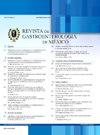Recomendaciones de buena práctica clínica para el uso de neuromoduladores en gastroenterología: revisión conjunta de expertos de la Asociación Mexicana de Gastroenterología (AMG) y Asociación Mexicana de Neurogastroenterología y Motilidad (AMNM)
IF 1.7
Q3 GASTROENTEROLOGY & HEPATOLOGY
引用次数: 0
Abstract
Disorders of gut-brain interaction (DGBI) are characterized by alterations in both central and peripheral gut-brain axis (GBA)-related stimuli, and include esophageal, gastroduodenal, intestinal and anorectal disorders. Despite the fact that several pathophysiologic mechanisms are involved, the mainstay of treatment is neuromodulators, a heterogeneous group of drugs that act on pathways related to central and peripheral pain processing. This expert review by both the AMG (Asociación Mexicana de Gastroenterología) and AMNM (Asociación Mexicana de Neurogastroenterología y Motilidad) summarizes a series of updated clinical recommendations based on an exhaustive review of the literature, regarding the use of neuromodulators for DGBI, and is grouped into six sections: pharmacologic principles, definition, classification, mechanism of action; indications and use in each DGBI subtype; up/downscaling strategies, combination therapy; adverse events; joint use along with psychiatry in the case of comorbidities; and non-pharmacologic neuromodulation. Furthermore, drug selection process tips and dose personalization according to individual groups and sensitivities are provided, and special cases with DGBI-psychiatric comorbidity, as well as overlap with another DGBI, are considered.
关于在胃肠病学中使用神经调节剂的良好临床实践的建议:墨西哥胃肠病学协会(AMG)和墨西哥神经胃肠病学和运动协会(AMNM)专家的联合审查
肠-脑相互作用紊乱(DGBI)的特征是中央和外周肠-脑轴(GBA)相关刺激的改变,包括食管、胃十二指肠、肠道和肛肠疾病。尽管涉及多种病理生理机制,但主要的治疗方法是神经调节剂,这是一组不同的药物,作用于与中枢和外周疼痛处理相关的途径。AMG (Asociación Mexicana de Gastroenterología)和AMNM (Asociación Mexicana de Neurogastroenterología y Motilidad)的专家综述总结了一系列最新的临床建议,这些建议是基于对文献的详尽回顾,关于使用神经调节剂治疗DGBI,并分为六个部分:药理学原理、定义、分类、作用机制;每种DGBI亚型的适应症和用法;上/下规模策略,联合治疗;不良事件;在有合并症的情况下与精神科联合使用;非药物神经调节。此外,根据个体群体和敏感性提供药物选择过程提示和剂量个性化,并考虑DGBI-精神合并症的特殊情况,以及与另一DGBI重叠的情况。
本文章由计算机程序翻译,如有差异,请以英文原文为准。
求助全文
约1分钟内获得全文
求助全文
来源期刊

Revista de Gastroenterologia de Mexico
GASTROENTEROLOGY & HEPATOLOGY-
CiteScore
1.60
自引率
12.50%
发文量
102
审稿时长
12 weeks
期刊介绍:
La Revista de Gastroenterología de México es el órgano oficial de la Asociación Mexicana de Gastroenterología. Sus espacios están abiertos a los miembros de la Asociación como a todo miembro de la comunidad médica que manifieste interés por utilizar este foro para publicar sus trabajos, cumpliendo con las políticas editoriales que a continuación se mencionan. El objetivo principal de la Revista de Gastroenterología de México, es publicar trabajos originales del amplio campo de la gastroenterología, así como proporcionar información actualizada y relevante para el área de la especialidad y áreas afines. Los trabajos científicos incluyen las áreas de Gastroenterología clínica, endoscópica, quirúrgica y pediátrica.
 求助内容:
求助内容: 应助结果提醒方式:
应助结果提醒方式:


